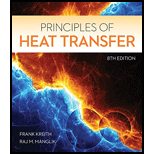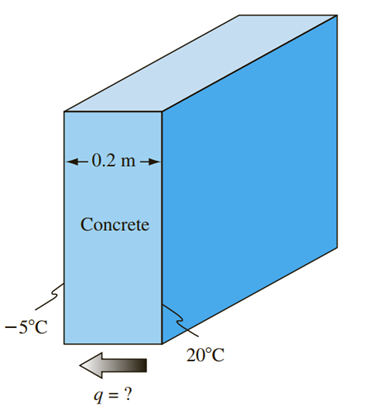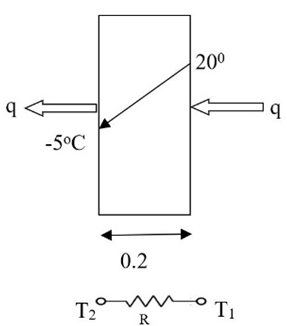
Concept explainers
On a cold winter day, the outer surface of a 0.2-m-thick concrete wall of a warehouse is exposed to temperature of –5°C, while the inner surface is kept at 20°C. The thermal conductivity of the concrete is 1.2 W/m K. Determine the heat loss through the wall, which is 10-m long and 3-m high.

Problem 1.1
Heat loss through the wall
Answer to Problem 1.1P
Heat loss through the wall is 4.5 kW.
Explanation of Solution
Given Information :
Temperature of the inner surface of the wall T1 = 200C
Temperature of the outer surface of the wall T2 = -50C
Thickness of the wall (L) = 0.2m, Thermal conductivity of the wall (k) = 1.2 W/m.K, Length of the wall is 10m, and height of the wall is 3m.
The rate of heat loss from the inner surface to outer surface of the wall is obtained from equation 1

Thermal resistance to heat conduction for a plane wall can be obtained by the equation given below.
“A” is an area of the wallperpendicular to the direction of heat flow.
Area of heat flow (A) =10 x 3 = 30m2
Substituting the values in Equation2, we get,
Substitute the value of R in Equation1
Conslusion:
Heat loss through the wall is 4.5 kW.
Want to see more full solutions like this?
Chapter 1 Solutions
Principles of Heat Transfer (Activate Learning with these NEW titles from Engineering!)
- 1.10 A heat flux meter at the outer (cold) wall of a concrete building indicates that the heat loss through a wall of 10-cm thickness is . If a thermocouple at the inner surface of the wall indicates a temperature of 22°C while another at the outer surface shows 6°C, calculate the thermal conductivity of the concrete and compare your result with the value in Appendix 2, Table 11.arrow_forwardAs a designer working for a major electric appliance manufacturer, you are required to estimate the amount of fiberglass insulation packing (k = 0.035 W/m K) that is needed for a kitchen oven shown in the figure below. The fiberglass layer is to be sandwiched between a 2-mm-thick aluminum cladding plate on the outside and a 5-mm-thick stainless steel plate on the inside that forms the core of the oven. The insulation thickness is such that the outside cladding temperature does not exceed 40C when the temperature at the inside surface of the oven is 300C. Also, the air temperature in the kitchen varies from 15Cto33C, and the average heat transfer coefficient between the outer surface of the oven and air is estimated to be 12.0W/m2K. Determine the thickness of the fiberglass insulation that is required for these conditions. What would be the outer surface temperature when the inside surface of the oven is at 475C?arrow_forwardA cooling system is to be designed for a food storage warehouse for keeping perishable foods cool prior to transportation to grocery stores. The warehouse has an effective surface area of 1860 m2 exposed to an ambient air temperature of 32C. The warehouse wall insulation (k=0.17W/(mK)) is 7.5 cm thick. Determine the rate at which heat must be removed (W) from the warehouse to maintain the food at 4C.arrow_forward
- 1.39 On a cold winter day, the outside wall of a home is exposed to an air temperature of when the inside temperature of the room is at . As a result of this temperature gradient, there is heat loss through the wall to the outside. Consider the convective heat transfer coefficients for the air inside the room and at the outside wall surface to be, respectively, 12.0 and . If the composite room wall is modeled as a plane wall with a thermal resistance per unit area of , determine the temperature at the outer surface of the wall as well as the rate of heat flow through the wall per unit area. If the homeowner were to consider using a fiberglass insulation layer on the inside wall surface for reducing this heat loss by 50%, what is the required thickness of this layer and the outside wall temperature for this case?arrow_forwardA composite wall layer consists of layer A covered by layer B. The thermal resistance of layer A is 0.75 °C/W and the thermal resistance of layer B is 2.50 °C/W. The exposed surface of layer A is at a temperature of 60°C. If the heat transfer per unit area across the composite wall is 30 W/m?, what is the temperature at the interface between layer A and layer B? Express your answer in °C.arrow_forwardA1 m-wide by 2 m-high window is composed of two 5 mm-thick glass panes, separated by an air space of 10 mm. The temperatures at the inner and outer surfaces of the window are 15°C and -20°c respectively. If the thermal conductivities of the glass pane and the air space are 1.4 respectively, find the total rate of heat loss from the window in W? and 0.024 m-K m-Karrow_forward
- In a coal-fired power plant, a furnace wall consists of a 125-mm-wide refractory brick and a 125-mm-wide insulating firebrick separated by an air gap. The outside wall is covered with a 12 mm thickness of plaster. The inner surface of the wall is at 1100◦C, and the room temperature is 25◦C. The heat-transfer coefficient from the outside wall surface to the air in the room is 17 W/m2 K, and the resistance to heat flow of the airgap is 0.16 K/W. The thermal conductivities of the refractor brick, the insulating firebrick, and the plaster are 1.6, 0.3, and 0.14 W/m K, respectively. Calculate the rate of heat loss per unit area of wall surfacearrow_forwardA cold-storage room is constructed of an inner layer of 11 mm of pine with thermal conductivity of 0.15 W/m K, and an outer layer of 75 mm of concrete with thermal conductivity of 0.75 W/m K. The wall surface temperature is 253 K inside the cold room and 299 K at the outside surface of the concrete. Calculate the heat loss in W per 1 m2. Please keep one decimal and take positive value for the final answer.arrow_forwardAn isolating wall (made up of 2-10mm thick plywood with 5mm woven silica sheet in between) encloses a steam-room to prevent the outside area from having the same temperature as the inside of the room. If the total area of the wall is 100 sq.m. and coefficient of thermal conductivity (k) for plywood and silica sheets are 0.12 and 0.015 W/mK respectively, what is the rate of heat transfer if the inside temperature is 800 °C while the outside is 42°C? answer must be in Wattsarrow_forward
- An isolating wall (made up of 2-10mm thick plywood with 5mm woven silica sheet in between) encloses a steam-room to prevent the outside area from having the same temperature as the inside of the room. If the total area of the wall is 100 sq.m. and coefficient of thermal conductivity (k) for plywood and silica sheets are 0.12 and 0.015 W/mK respecțively, what is the rate of heat transfer if the inside temperature is 800 °C while the outside is 42°C? answer must be in Watts * Your answerarrow_forwardQuestion 4 The window of a room is made of 5 mm thick glass which has a thermal conductivity of 1.4 W/m-K. A heater is used to maintain the room temperature at 22 °C. Take the convection heat transfer coefficients on the outer surface of the window to be 12 W/m²-K. Take appropriate assumptions while solving this problem. (a) T₁=15°C TA -A- 1m x 3m = 3m², k=1.4W/m-K -T₂=5°C L=0.005m Figure Q2 Determine the heater thermal load to maintain the room temperature?arrow_forwardQuestion 2 Figure 2 shows the cross-sectional of inner and outer surfaces of a 4 m x 7 m brick wall with thickness of 30 cm and thermal conductivity 0.69 W/m.K. The inner and outer surfaces are to be maintained at temperatures of 26°C and 8°C, respectively. Determine the rate of heat transfer through the wall, in W. Answer: 26°C Brick wall 30 cm Figure 2 8°Carrow_forward
 Principles of Heat Transfer (Activate Learning wi...Mechanical EngineeringISBN:9781305387102Author:Kreith, Frank; Manglik, Raj M.Publisher:Cengage Learning
Principles of Heat Transfer (Activate Learning wi...Mechanical EngineeringISBN:9781305387102Author:Kreith, Frank; Manglik, Raj M.Publisher:Cengage Learning
